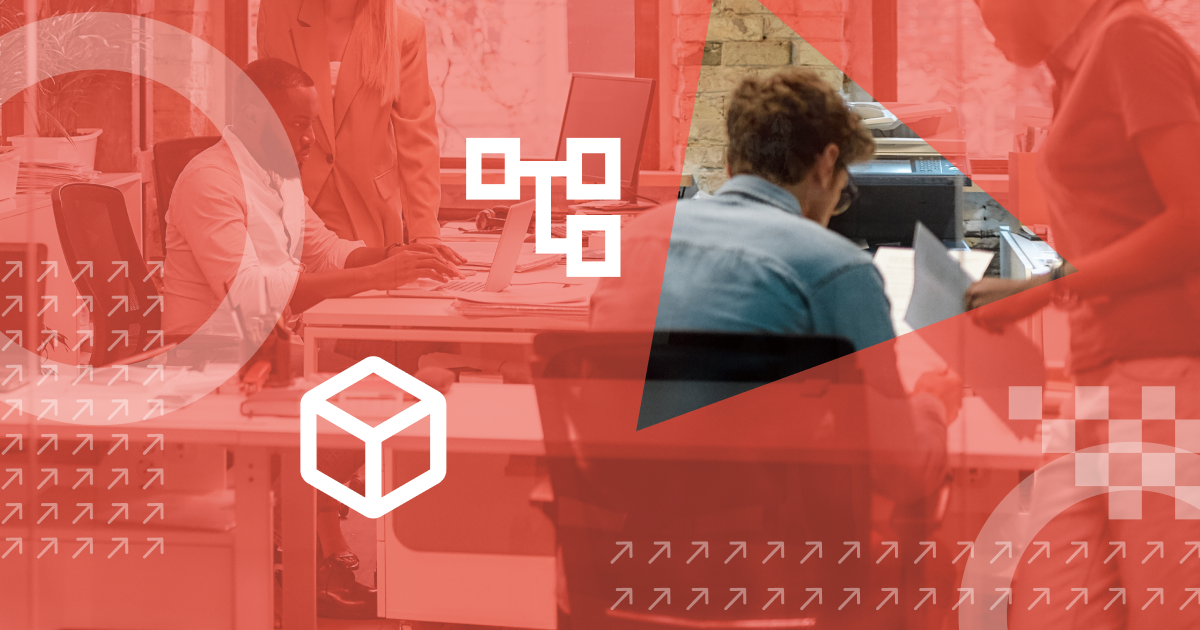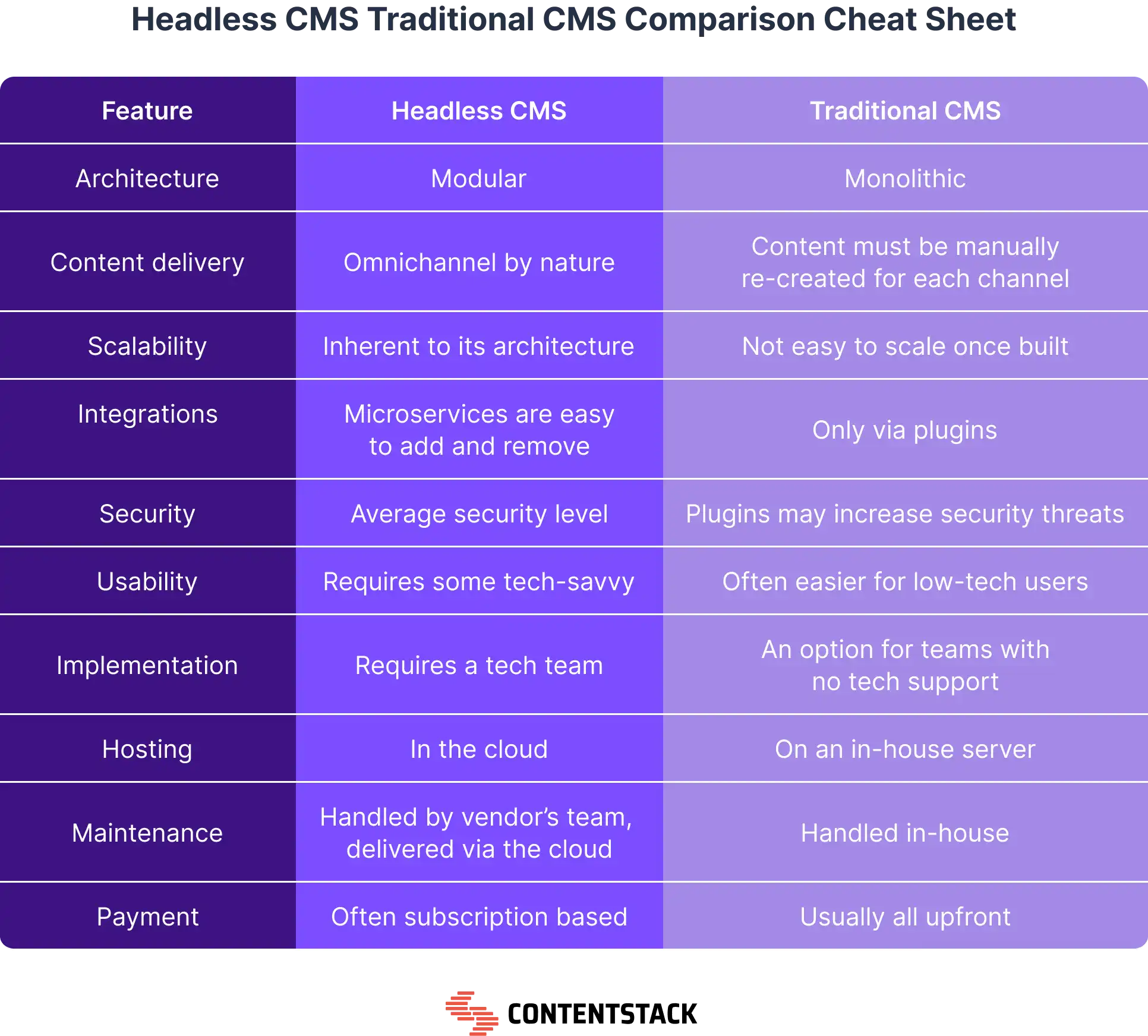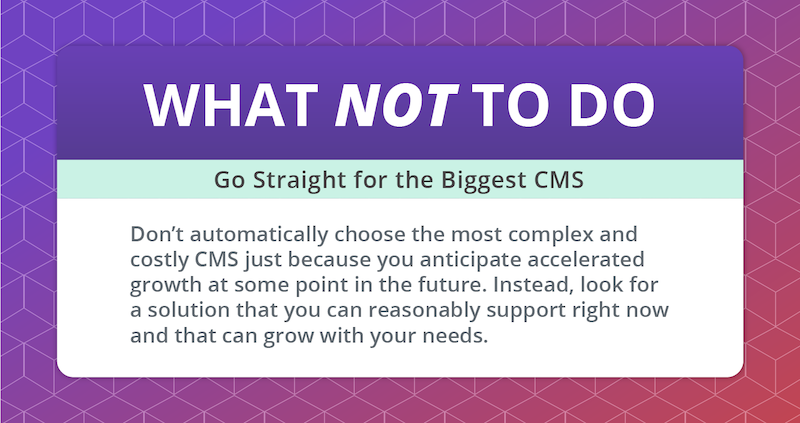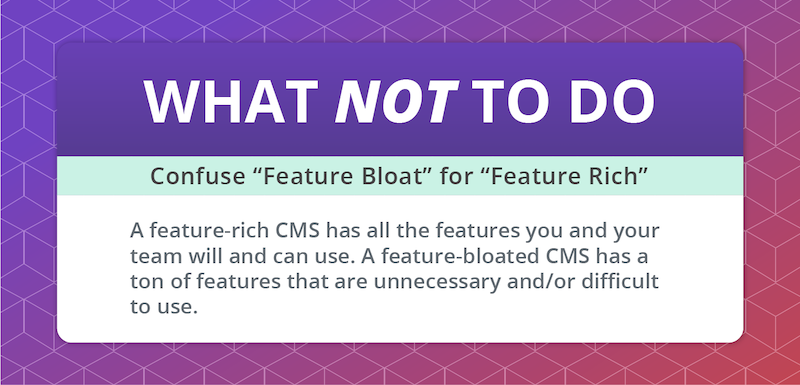Your roadmap to successful website replatforming

Transform your online business with proven website replatforming strategies. You can avoid pitfalls like cost overruns and SEO disruptions by choosing scalable, future-ready platforms like Contentstack. If you want your e-commerce to reach new heights, schedule a demo with us today.
Highlights
You’ll learn:
- How to understand website and e-commerce replatforming
- The reasons for web replatforming, its strategies, benefits and best practices
- How it impacts your business operations, including sales, marketing and customer service
- About the potential mistakes you can make during the migration process
Replatforming is not just about changing your e-commerce platform; it's a strategic move towards operational efficiency, improved customer experience and sustained business growth.
Keep reading to explore more!
Every business differentiates itself from competitors by keeping pace with the latest technological trends. Often, this means making changes to their digital assets, including websites.
It’s not only about a re-design. It’s more about positioning your website and applications to outclass competitors and delivering seamless content and user experience (UX) to visitors.
That’s where the concept of website replatforming comes in.
You might consider website replatforming for your business because of numerous reasons.
But what is website replatforming?
Let’s get started.
What is website replatforming?
Website replatforming or website migration is changing your current content management system (CMS) to another, ideally a headless content management system (CMS). Similar to shifting to a new location, this replatforming process might be time-consuming.
However, when the migration is successful, transitioning to a new headless CMS can bring invaluable change to your business. Many companies use replatforming to reposition their website’s technology to ensure it succeeds in the internet landscape.
In replatforming, you build a new website by prioritizing the underlying infrastructure powering it. It has nothing to do with improving its aesthetics.
You may think your website is perfectly fine and doesn’t require any change, but website replatforming often becomes necessary when technology evolves, as do customer requirements and expectations. If you ignore website migration, your website will show its age in performance sooner or later.
Let’s understand using an example:
You have a retail website built on a monolithic CMS. Your existing CMS lacks the flexibility and scalability to handle traffic during peak season. Besides performance issues, your team faces issues integrating a new payment gateway and your website lacks the desired web responsiveness. To address this major issue, consider migrating from your old CMS to a headless CMS like Contentstack.
Reasons for website replatforming
Did you know that 35% of B2B companies want to migrate to another e-commerce platform because they need commerce software adapted to their needs and hosted externally in a single-tenant environment? You might be among these 35% of businesses if you’re facing one or more of these challenges:
You want to provide an omnichannel experience
Many companies, including e-commerce stores, prefer to migrate to a headless CMS because it provides an omnichannel experience. Offering omnichannel customer experience helps you reach new customers. This improves your customer engagement and interactions.
You face security issues
Cybersecurity threats are a constant concern for online businesses. If you face security issues, consider migrating to a headless CMS to keep your business data and customer information safe. Also, following a security breach, a company may migrate to a safer CMS that offers end-to-end encryption, regular security updates and compliance with data protection regulations.
You face integration challenges
In a traditional CMS, you cannot integrate third-party applications and services. Migrating to a headless CMS is a great option. Replatforming allows you to select a platform with better support for integrations, ensuring seamless connection with CRMs, payment gateways and marketing tools.

You face performance issues
Your website's ability to handle increased traffic and provide fast loading times becomes critical as you grow. Replatforming to a more scalable platform ensures that the website can accommodate growth without compromising performance.
Case study: How did migration from a legacy CMS to a headless CMS help Burberry improve its performance?
Burberry's digital transformation journey involved migrating to Contentstack’s headless CMS to enhance speed, provide agility and ensure multilingual capabilities. After migrating to a headless CMS, Burberry witnessed improvements in content creation, reduced developer requests, accelerated translation processes and improved global website performance. The results included an 80% increase in publishing speed and enhanced design flexibility for landing pages.
Listen to what Sonia Latoracca, Digital Commerce Content Manager at Burberry, said:
“Creating content is quicker and easier with Contentstack. It’s a user-friendly tool making training and onboarding simpler. The integration with our translation and media systems means content can be created and published much quicker. The flexible, reusable components allow us to complete new design briefs without the need for constant development.”
Read the case study here.
You face marketing limitations
When your marketing cannot perform key tasks, such as launching new marketing campaigns without developer support, you must migrate your existing content management system. If you face difficulties with personalization or require additional features to bring your marketing strategy to the next level, you may choose replatforming.
Website replatforming strategies
Use these strategies to migrate your existing CMS to a headless CMS:
Set clear objectives
The first step in web replatforming is defining achievable and tangible objectives. These objectives work like a roadmap and align with your business objectives. Your objectives can be to enhance the user experience, increase the site’s performance and improve cybersecurity measures.
For instance, an e-commerce platform may aim to reduce its cart abandonment rate. They can achieve their goal by implementing a more intuitive checkout process on the new platform.
Plan your timeline
A detailed timeline helps you manage the migration from one platform to another, making the process efficient. For instance, if your re-launch date clashes with an upcoming product release, you can create a backward schedule from the product release date to achieve the replatforming time.
Allocate resources
To replatform your website to another platform, allocate your resources to the finance, human resource and technology domains. Through this process, you decide the budget for migrating to a headless CMS. Combine your in-house expertise with external resources to ensure a seamless transition to a new CMS.
For instance, you set aside one portion of the budget to use a headless CMS and the second to train your development team.
Involve your team members
Get your teammates from IT, marketing, customer service and sales departments. Their expertise helps you personalize the new system based on the different requirements of each department.
Having your marketing team involved early in the planning phase will make it easier to determine what qualities to look for, such as better SEO or social media integration. So, you settle for a CMS platform that suits your business needs and customers' expectations.
Best practices for website replatforming
For successfully migrating your website, follow these best practices:
Pay special attention to your SEO rankings
While platform migration will affect your SEO, it’s not an obstacle if your plan follows a migration strategy. Here’s how website replatforming impacts your search engine rankings:
- Changing your URL results in bad links and 404 error pages.
- Decreasing your trust in the search engine.
- Any changes to your website architecture will reduce your page authority, reducing the quality of your high-ranking SEO pages.
The meta-description and your keyword ranking are reduced because of any significant change in the page content. Any outage during the migration results in lower website availability to search engines and users.
You can focus and maintain your SEO rankings by:
- Before the migration, audit your website’s SEO strengths and weaknesses, check for broken links and assess its structure.
- Preserve your link equity by keeping the current URL structure after migration.
- Pay close attention to all internal links and ensure they point to the correct URL.
- Ensure a post-migration audit to identify and address issues.
Safeguard data integrity
Perform an in-depth website content audit during the migration. This audit creates a checklist containing every piece of data, including customer records and transactions, to prevent data loss or corruption. Protecting your customers' data during a website migration will reassure them that they can continue doing so confidently.
Minimize downtime
To ensure zero downtime migration, perform the replatforming process during non-business hours. These hours will not affect your customers’ experience. Reducing downtime enhances overall performance and, in the long run, positively affects your bottom line.
Fast-track digital experiences with Contentstack. Need to create digital experiences quickly? Contentstack's content and editorial engine enables you to reach new markets and create digital experiences faster. Manage content with ease and speed. Start your free trial today.
How website replatforming impacts your business operations
Website replatforming is a strategic move helping you shift your website to a new platform. Here’s how platforming impacts your business operations:
Impact on sales
A successful replatforming project leads to increased conversion rates. How?
A headless CMS offers faster load times, intuitive navigation and mobile optimization. It decreases bounce rates and the number of people who abandon their shopping carts, leading to increased conversion rates.
Besides this, headless CMS improves your SEO capabilities, making it easier for clients to find the business online. Advanced CMSes even support multi-language features, helping you reach an international market.
Impact on customer service
Website migration enhances your website's overall performance and user experience, significantly impacting customer service operations.
The challenges in migrating a website—such as changes to its structure, design, or hosting environment— lead to temporary disruptions affecting accessibility and functionality.
For instance, during the migration phase, customers may encounter difficulties accessing the site, completing transactions or finding familiar resources, increasing the volume of inquiries and complaints. Because of the migration, your customer service team witnesses an uptick in complaints and feedback volume.
To effectively manage these challenges, businesses must adopt a proactive approach to customer service during website migration. This involves communicating the upcoming changes to customers well in advance, providing detailed information about what to expect and how to access assistance if needed.
Impact on marketing
The marketing department gains considerably from website replatforming. Modern headless CMS offers more sophisticated content management capabilities, helping you create, manage and optimize content. This increases your content marketing efforts and engagement strategies.
Additionally, advanced data analytics tools on a headless CMS offer effective personalization and targeting in marketing campaigns. Headless CMS enables you to segment your target audiences and personalize their in-store messages, eventually leading to high engagement and conversion.
Benefits of e-commerce replatforming
Legacy e-commerce solutions leave you wanting more because you spend more on hosting, upgrades, maintenance and updates. To avoid these bottlenecks, companies often replatform their website from monolithic to composable commerce. Here are some benefits of going composable:
Makes your system more scalable
Unlike monolithic systems, where scaling up often means expensive and time-consuming overhauls, composable commerce platforms ensure efficient scaling of individual components. Scalable systems lead to improved performance, reduced costs and better resource allocation.
Decreases speed to market
A composable environment provides faster speed to market for new features or services. In composable commerce, changes made to one component don’t impact the other components, helping you introduce new functionalities much faster. When you emphasize continuous improvement and innovation, you keep your businesses ahead of the competition.
Enhances flexibility
Flexibility is a key advantage of composable commerce platforms. Businesses can easily adapt to changing market demands by swapping or adding new components without disrupting the system.
Cost-effectiveness
Another benefit of adopting a composable approach is cost-effectiveness. You can invest in specific components as needed, avoiding large upfront costs associated with traditional monolithic systems. This pay-as-you-go model ensures efficient resource allocation.
E-commerce replatforming checklist
E-commerce replatforming is a significant decision, but it can lead to cost savings and immense growth. You start by assessing your existing platform, followed by defining your goals. Then, you search for a platform that suits your requirements.
Here’s an e-commerce platforming checklist that comes in handy to ensure successful replatforming.
Assess your platform
The first step in your e-commerce replatforming is to assess the performance of your existing platform. Understand whether it is scalable and functional enough. Perform a complete assessment to learn if your existing platform is flexible and become more agile as your business needs increase.
Key elements to consider when assessing your existing systems include:
Feature | Description |
Performance | Is your website speed fast? Is it mobile-responsive? |
Functionality | What functionalities are missing from your existing e-commerce platform? |
Security | Is your existing system capable of securing sensitive customer data? |
User experience | Is your system easy to use and navigate? Does it provide a seamless user experience? |
Scalability | Can your e-commerce platform handle an increase in traffic without compromising on performance? |
While it might be frustrating to check every aspect, an in-depth evaluation of your website can help you detect features of your new platform.
Define your goals
Clearly defining your goals and what you expect to achieve from e-commerce replatforming is essential. Outline the following elements:
- Business goal: What is your business goal? Do you want to improve customer experience, lower cart abandonment rate, or enter a new market?
- Functional requirements: What features do you require in the new platform? Are you seeking data analytics, inventory management, payment gateways or customer relationship management (CRM)?
- Technical considerations: What hosting options are available? Which data migration strategies do you plan to implement? How compatible is your new system with your existing one?
- User experience: What user experience issues is your customer-facing? What’s their feedback on your existing e-commerce platform?
Search for a new platform
Based on your business goals and evaluation of your existing platform, choose your new e-commerce platform. Look for these features in your new e-commerce platform:
- Customization and scalability options
- Robust security features
- Integration with shipping options and payment gateways
- Level of customer support
- Data analytics capabilities


Plan your migration strategy
Data migration forms the backbone of your e-commerce replatforming. Create a detailed list on how you will migrate the following to your new platform:
- Product information
- Customer data
- Order histories
- Content
Data migration typically involves the following steps:
Steps | Description |
Preparation and planning | Assess the scope of data you want to migrate and outline the data migration plan. Identify key data sets, migration tools and timelines. |
Data cleansing | Ensure your data is free from duplicates, errors and outdated information. Cleanse your data to ensure accuracy. |
Data mapping | Map data elements from the source to the target system and clearly define transition rules and data relationships. |
Trail migration | Conduct a trial migration with a subset of data. This tests the migration process and uncovers potential issues. |
Full migration | Proceed with the full migration of data. Monitor the migration process closely for any errors or issues. |
Data validation | Validate the migration with stakeholders. Confirm that the data is accurate and the system is operational. |
Data migration is critical if your existing e-commerce platform uses complex features, order history and customer profiles. You need to map and validate data to ensure everything is replatformed carefully.
Start your free trial with Contentstack today. Transform your brand's digital presence with Contentstack's open MACH architecture and industry-leading technology. Witness a significant reduction in publishing and development time, and elevate your content management. Start your free trial now.
Mistakes in e-commerce replatforming
While e-commerce replatforming comes loaded with features businesses cannot ignore, it has its limitations. During the platforming process, avoid these pitfalls:
You underestimate the cost and time requirement
One of the businesses' biggest mistakes is incorrectly estimating the cost and time to replatform. Unforeseen delays and budget overruns are common risks that impact the entire process.
You perform inadequate platform evaluation
Another mistake is choosing the wrong platform because of a lack of research. A wrong platform defeats the entire purpose of website replatforming. Platforms like Shopify, even though popular, have limitations in SEO performance. However, cloud-based headless commerce platforms like Contentstack can help you overcome these issues.
You overlook data migration challenges
Data migration is risky because incorrect data mapping results in data loss. For any business, data loss is a potential threat with far-reaching consequences.
You ignore the impact of SEO and organic traffic
Replatforming reduces your organic traffic and SERP rankings if you don’t integrate SEO considerations into the migration strategy.
You ignore scalable platforms
Choosing a platform that cannot accommodate future growth prevents your business from achieving its long-term goals.
FAQs
What is an example of replatforming?
A notable example of replatforming is when an e-commerce business moves from a monolithic, static platform to a more flexible and scalable headless commerce platform. This will improve the site’s performance, provide better personalization and increase users’ engagement and sales.
How is refactoring different from replatforming?
Refactoring improves the internal structure of your software code by introducing additional new code without altering the external appearance of the software. Replatforming is a strategy opposite to this. Its main goal is to move to a highly scalable, agile and flexible platform.
What are the advantages of replatforming to a new platform?
The upsides of replatforming include faster site performance, better user experience and greater potential to add new features and technologies. This process enables companies to react to the market and customer’s dynamically changing requirements.
What is e-commerce replatforming?
E-commerce replatforming is the process of moving an online store from one e-commerce platform to another. Online stores resort to replatforming to address the existing system's performance issues, restricted customization ability, substandard performance and high maintenance costs.
Learn more
Website replatforming is strategically important in digital transformation and cannot be overlooked. Businesses that ignore the need to migrate to a new CMS or fail to adopt the latest technological trends are the ones that deliver bad user experiences.
If you don’t want to be tagged as an ignorant business, schedule a free demo to explore how our solutions can make your replatforming smooth and quick while driving digital success.
About Contentstack
The Contentstack team comprises highly skilled professionals specializing in product marketing, customer acquisition and retention, and digital marketing strategy. With extensive experience holding senior positions at renowned technology companies across Fortune 500, mid-size, and start-up sectors, our team offers impactful solutions based on diverse backgrounds and extensive industry knowledge.
Contentstack is on a mission to deliver the world’s best digital experiences through a fusion of cutting-edge content management, customer data, personalization, and AI technology. Iconic brands, such as AirFrance KLM, ASICS, Burberry, Mattel, Mitsubishi, and Walmart, depend on the platform to rise above the noise in today's crowded digital markets and gain their competitive edge.
In January 2025, Contentstack proudly secured its first-ever position as a Visionary in the 2025 Gartner® Magic Quadrant™ for Digital Experience Platforms (DXP). Further solidifying its prominent standing, Contentstack was recognized as a Leader in the Forrester Research, Inc. March 2025 report, “The Forrester Wave™: Content Management Systems (CMS), Q1 2025.” Contentstack was the only pure headless provider named as a Leader in the report, which evaluated 13 top CMS providers on 19 criteria for current offering and strategy.
Follow Contentstack on LinkedIn.




.svg?format=pjpg&auto=webp)
.svg?format=pjpg&auto=webp)
.png?format=pjpg&auto=webp)






.png?format=pjpg&auto=webp)

